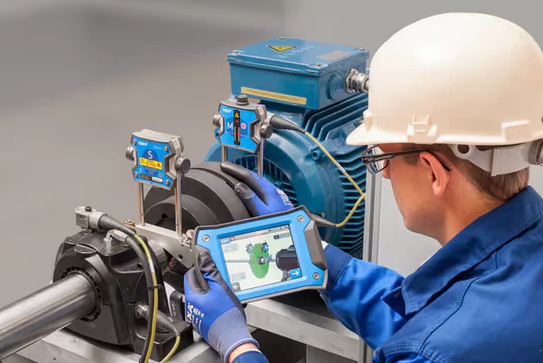When it comes to maintaining industrial machinery, precision is everything. One of the most crucial aspects of keeping your equipment running smoothly is ensuring proper shaft alignment. Enter laser shaft alignment: a modern technique that has revolutionized how we align rotating equipment. If you’re looking to enhance efficiency, reduce wear and tear on components, and avoid costly downtime, mastering laser shaft alignment techniques can be a game-changer.
This guide will take you through the ins and outs of laser shaft alignment. From understanding its benefits to providing detailed steps for successful execution, you’ll gain valuable insights that can elevate your maintenance skills. Grab your tools; let’s dive into the world of laser technology and learn how to get those shafts perfectly aligned!
What is Laser Shaft Alignment?
Laser shaft alignment is a precise technique used to align the rotational axes of two or more shafts. This process ensures that components like motors, pumps, and gearboxes work harmoniously together.
By employing laser technology, this method eliminates guesswork. It provides real-time feedback on any misalignment issues. Unlike traditional methods that rely heavily on physical indicators, laser systems utilize advanced optics to measure angles and distances with astonishing accuracy.
This approach not only improves operational efficiency but also extends the life of machinery. Proper alignment minimizes vibration and reduces wear on bearings and seals, leading to lower maintenance costs over time.
In industries where uptime is critical, mastering laser shaft alignment can significantly impact productivity levels. The ease of use combined with its effectiveness makes it an essential skill for technicians and engineers alike.
Benefits of Laser Shaft Alignment
Laser shaft alignment offers a multitude of advantages for industrial machinery. One of the most significant benefits is its precision. The laser technology provides highly accurate measurements, ensuring that shafts are aligned with minimal error.
Another key advantage is reduced downtime. When machines run smoothly due to proper alignment, maintenance intervals can be extended. This means less time spent on repairs and more productivity overall.
Moreover, implementing laser alignment can lead to energy efficiency gains. Misaligned shafts often create excessive friction, leading to increased power consumption. By aligning your equipment correctly, you not only save energy but also prolong the life of your machinery.
Additionally, using this advanced technique minimizes wear and tear on components like bearings and seals. This proactive approach lowers replacement costs in the long run while enhancing operational reliability across various applications in manufacturing or production environments.
Understanding the Equipment and Tools Needed
To achieve precise laser shaft alignment, having the right equipment is essential. At the core of this process is a laser alignment system. This typically includes a laser transmitter and receiver, which work together to measure misalignments accurately.
In addition to the main units, there are adapters or brackets needed for securing the devices onto shafts. These ensure stability during measurement and adjustment phases.
You’ll also want to have calibration tools on hand. A good understanding of your tool’s specifications will help you make necessary adjustments efficiently.
Don’t forget about protective gear as well. Safety glasses can protect your eyes from bright lasers while working in industrial environments adds another layer of safety when handling heavy machinery. Consider software options that can simplify data analysis and display results clearly for better decision-making.
Preparing for the Alignment Process
Preparation is crucial for a successful laser shaft alignment. Start by ensuring the workspace is clean and organized. Remove any debris or obstacles that might interfere with your measurements.
Next, gather all necessary tools and equipment. This includes the laser alignment tool, brackets, and measuring devices. Check that everything is calibrated correctly to avoid discrepancies during the process.
It’s also important to review the machinery specifications beforehand. Understanding tolerances will guide you in making accurate adjustments later on. Make sure to communicate with your team about safety protocols.
Knowing who’s responsible for different tasks can streamline operations significantly. Conduct a quick inspection of the shafts and couplings before starting. Look for signs of wear or damage that could affect alignment outcomes down the line.
Step 1: Establishing a Reference Point
Establishing a reference point is crucial in laser shaft alignment. This step sets the groundwork for all subsequent measurements and adjustments.
Begin by identifying an immovable structure, like the machine frame or base. This will serve as your anchor point throughout the process. Make sure it’s clean and free from debris to prevent inaccuracies.
Next, mount the laser transmitter securely on this reference point. Ensure that it aligns perfectly with the shaft axis you’re working on. A stable setup minimizes errors during measurement. Take a moment to double-check your positioning before proceeding.
Any slight misalignment here can lead to significant issues later on. Trust this initial phase; it’s essential for achieving precise results down the line. With a solid foundation established, you’re ready to move forward confidently into taking those initial measurements.
Step 2: Taking Initial Measurements
Once your reference point is established, it’s time to gather some initial measurements. This step is crucial for understanding the current alignment status of the shafts.
Begin by placing the laser emitter on the driving shaft. Ensure that it’s securely fastened and level. Next, activate the device and let it project a beam towards the receiving unit attached to the driven shaft.
As you take these readings, pay close attention to any variations in distance or angle displayed on your screen. These numbers provide insight into how misaligned your equipment may be.
It’s essential to repeat this process several times for accuracy. Consistency in measurements will help identify any anomalies caused by environmental factors or machine vibrations during testing. Document everything meticulously; having precise data is key when moving forward with adjustments later on.
Step 3: Adjusting Misalignments
With the initial measurements in hand, it’s time to tackle any misalignments. Start by carefully examining the data you’ve gathered. Identify how far off your shafts are from their ideal positioning.
Using your adjustment tools, begin making small corrections. A gentle touch is key here; overcompensation can lead to further issues down the line. Always double-check after each adjustment.
After each tweak, take another round of measurements. This iterative process helps ensure you’re moving closer to perfect alignment without overshooting it. Don’t hesitate to consult your equipment’s manual for specific guidance on adjustments related to its unique design.
Patience plays a vital role during this stage—rushing may compromise accuracy and can lead you back to square one. Trust the process and stay focused as you refine those alignments bit by bit. The goal is precision, not just speed.
Additional Tips and Tricks for a Successful Alignment
To enhance your laser shaft alignment efforts, consider ambient conditions. Ensure the workspace is clean and free from vibrations. This significantly impacts accuracy. Use a quality leveling tool to confirm that the machine base is properly leveled before starting measurements. Any tilt can lead to misalignment results.
Always double-check your initial readings before making adjustments. A small error in measurement can cascade into larger issues down the line. Document every step of your process, including measurements and adjustments made.
This record will be invaluable for future alignments or troubleshooting. When working with large machines, enlist a second pair of hands if possible. Having someone assist during setup can save time and reduce potential errors in alignment.
Stay updated on calibration processes specific to your equipment’s manufacturer recommendations for optimal performance outcomes. Keeping everything aligned ensures reliable operation over time.
Troubleshooting Common Issues
Troubleshooting common issues during laser shaft alignment can save time and prevent costly mistakes. One frequent problem is inaccurate measurements. This may stem from improper setup or unstable equipment. Ensure that the machinery is leveled and free from vibrations.
Another issue to watch for is miscommunication between devices. If your laser unit isn’t properly synced with its receiver, you’ll get misleading readings. Double-check all connections and settings before proceeding.
If you notice excessive backlash in couplings, it’s crucial to address this right away. A worn or damaged coupling can lead to significant alignment errors over time. Keep an eye out for environmental factors as well.
Temperature fluctuations can affect precision instruments, so try to perform alignments in controlled conditions whenever possible. Don’t hesitate to consult your equipment’s manual or reach out to support if something feels off; sometimes a fresh perspective is all that’s needed.
Conclusion
Mastering laser shaft alignment techniques can significantly enhance machinery performance and longevity. With the right understanding of equipment, preparation, and step-by-step processes, anyone can achieve precise alignments. The benefits are clear: reduced downtime, lower maintenance costs, and improved operational efficiency.
As you embark on your alignment journey, remember that practice makes perfect. Troubleshooting common issues will sharpen your skills further. Keep experimenting with new strategies to refine your approach.
Embrace the learning curve associated with laser shaft alignment. With patience and persistence, you’ll become proficient in ensuring optimal machine operation—an invaluable asset for any industrial setting or manufacturing process. Happy aligning!




